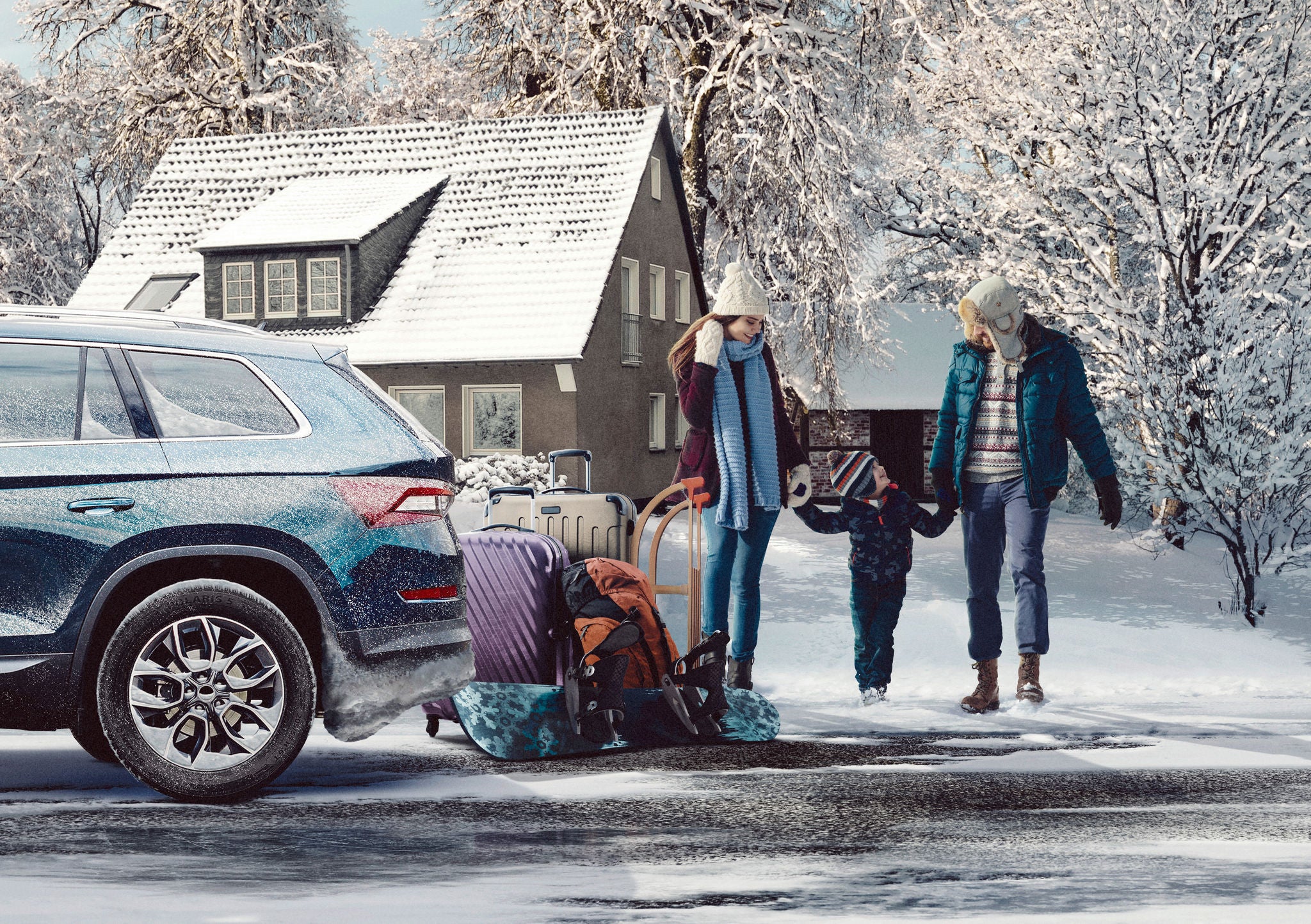
Ice, snow and darkness: Winter conditions are challenging for both drivers and tyres alike. Suitable winter tyres enhance safety out on the road. They increase stability and provide maximum grip. The perfect combination of material and tread make this possible. However, winter tyres cannot resolve all related driving issues on their own. As the driver, you’re also responsible. Always adjust your manner of driving to cope with difficult conditions. That is the only way to ensure that winter driving does not become a hazardous experience.

Driving in winter: Before moving off
You must clear all snow and ice from the vehicle before going anywhere. A clear view is of paramount importance. However, the hood and the roof should also be cleared of snow. Sharp braking may result in snow falling from the roof, quickly impairing vision. The traffic behind you is also affected by snow flying off the car.
Remove slush and ice from the wheel housing so you can steer properly. Before getting into the car, knock the snow off your shoes. This helps prevent windows from misting up on the inside. The greater the humidity in the vehicle interior, the quicker the windows will mist up.
Our Expert's Advice:

Do not run the engine when the vehicle is stationary to remove ice from the windows. This is forbidden and is harmful to the environment as well as the engine.
On the road: Winter driving tips
Is your car free of ice and snow? You can finally move off. However, the major pitfalls now await. Whether steering or braking, particular care is required on icy roads. Discover the three most important tips for driving safely in winter.
1. Drive gently, evenly and smoothly
Whether you're driving on ice, in snow or just in cold weather, winter weather makes the car react totally differently compared to summer conditions. It is more likely to skid and the braking distance also becomes longer. You must adjust your driving style accordingly. The fundamental principle: Always drive gently, evenly and smoothly and keep the speed down. Traffic lights and crossroads present particular hazards. Even light braking can be hazardous if there is not enough clearance for the car in front. Always maintain sufficient distance. A sound rule of thumb is: Three times the distance required for dry roads. Also remember that other drivers may be less cautious than you.
Our Expert's Advice:

Does your route to work go through heavy rush-hour traffic every morning? Traffic jams and delays often occur during snowy and icy conditions. Expect such trips to last longer and set off earlier than usual.
2. Move off carefully
Trying to move off in the snow but the car won’t move? Roads provide less traction in winter. The tyres keep spinning and dig even deeper into the snow. It is easier to make progress when driving in a lower gear. The power transmission is gentler and more effective. The result: Tyres have better grip and can handle the ground conditions better. It is therefore recommended that you drive in second gear in icy conditions. When changing gear, press and release the clutch slowly.
3. Pay attention to steering and braking behaviour
Do not only adjust your speed. Steering behaviour is different on snow and ice compared to in summer conditions. As an example, the car may quickly swerve on a bend. In this case: Release the clutch and do so quickly, but counter-steer sensitively. If the vehicle does not react to steering, then an emergency stop is the only remaining option.
Our Expert's Advice:

Get a sense of the changed steering and braking behaviour. Carry out a short check on the brakes in the meantime on a clear stretch of road. This helps you become more aware of the road conditions and the longer braking distance on snow and ice.
The right tyres: Winter tyres
Winter places much more stringent demands on tyres. Icy roads, snowy streets and cold temperatures require constant traction. The reliable solution: Winter tyres with a minimum tread depth of four millimetres. What requires particular attention when driving with winter tyres?
At what temperature do winter tyres become sensible?
Winter tyres are sensible when the temperature drops and consistently stays below seven degrees Celsius. They are specially designed to deliver full driving performance in cold temperatures. The softer rubber compound remains flexible below seven degrees Celsius, providing excellent traction.
How fast can you drive using winter tyres?
The permitted maximum tyre speed is set out and must be in line with the car’s top speed. However, winter tyres are an exception, as their permitted maximum speed must also be below that of the car. Why is this? Wintry road conditions prevent the car from being able to travel at its top speed. For example, you can fit winter tyres with a top speed of 190 km/h onto a car with a top speed of 240 km/h.
Our Expert's Advice:

The speed rating gives the maximum permitted speed for a tyre. This can be found on the tyre sidewall or the vehicle registration document.
Driving in snow: How fast can you drive with snow chains?
According to manufacturers of all snow chain types, the maximum speed is generally 30 mph. This ensures safe driving on snow-covered roads. The speed limit also prevents the chains from damaging the road surface.
Our Expert's Advice:

Snow chains must be fitted to the drive axle. The chains must be fixed to at least two edges of a drive axle on cars with all-wheel drive. Follow the manufacturer's information in the instruction manual.
Front-, rear-, or all-wheel drive – which is best in winter?
Cars with front-wheel drive are “pulled”. This means the drive is installed on both wheels on the car’s front axle. With rear-wheel drive, the car is “pushed”, as the drives are located on the rear axle wheels. All-wheel drive (also known as four-wheel drive) uses all four wheels to propel the car. What advantages and disadvantages do the various transmission types have in winter?
Front-wheel drive provides a high degree of stability during acceleration. When travelling, even icy roads are not a problem. It does have some weaknesses when moving off. The front wheels can readily spin in ice and snow and skidding may occur when going uphill. With rear-wheel drive in winter, the opposite applies. Hill starts are not a problem – even with luggage in the boot. However, the rear wheels are prone to swerving on icy roads.
Four-wheel drive provides optimum performance in wintry road conditions. Its strengths include excellent traction on icy and snowy roads. Wheels rarely spin and hill starts are straightforward as a result. The disadvantages include slightly delayed braking on downhill slopes as well as increased fuel consumption. Acquisition costs are also higher compared to wheels with front- and rear-wheel drive.

